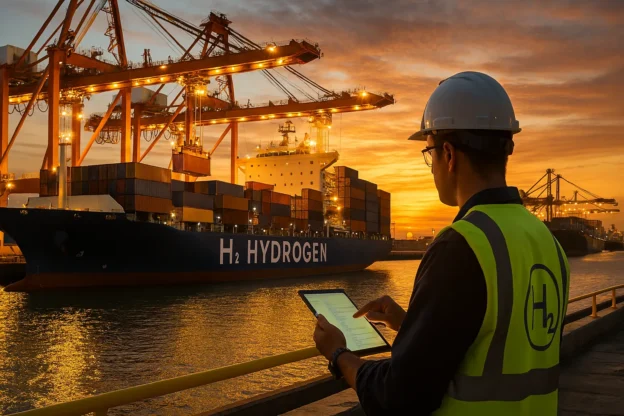Table of Contents
- The role of the human factor in the port energy transition
- Technological challenges in maritime terminals for clean fuels
- International regulations and their impact on port management
- Training and human talent for operational sustainability
- Hydrogen, ammonia, and biofuels in port infrastructure
- Digitization and environmental management in terminal operations
- Future prospects for maritime terminals and green transition
- Conclusion
- References
- Frequently Asked Questions (FAQs)
Maritime terminals operate in a context where sustainable maritime transport is driving the adoption of clean fuels such as hydrogen, ammonia, and advanced biofuels. Handling these fuels poses both technical and safety challenges, requiring not only modern infrastructure and advanced technology, but also sound human management. Trained personnel and constant supervision become essential elements in ensuring that operations are efficient, reliable, and compliant with current regulations, integrating safety, sustainability, and performance into every process.
It is not enough to have modern, automated equipment; operators, supervisors, and managers must be trained to make sound decisions, manage emergencies, and maintain the continuity of critical processes. The combination of human management and technology is therefore essential to ensure that the transition to clean fuels is carried out safely and sustainably.
This article explores how to integrate both elements into maritime terminals, analyzing operational challenges, technological solutions, applicable regulations, and best practices to implement.
The role of the human factor in the port energy transition
The human factor is a decisive component in port operations, as it represents the line of supervision and decision-making in complex processes. Experience shows that human error continues to be one of the main causes of incidents at maritime terminals. For this reason, it is essential to develop a strong safety culture, where transparent reporting of failures is encouraged without penalty, allowing incidents to be analyzed as opportunities for improvement.
In addition, the increasing automation and digitization of processes requires clear interfaces and understandable alert systems so that operators can intervene in critical situations without relying entirely on technology. Integrating human oversight with automated systems ensures efficiency and minimizes operational risks in highly complex environments.
Technological challenges in maritime terminals for clean fuels
Adapting port infrastructure for clean fuels poses significant challenges. Cryogenic hydrogen requires storage tanks with extreme insulation and materials resistant to embrittlement. Ammonia, meanwhile, presents challenges due to its toxicity and corrosiveness, requiring the use of special materials and robust containment systems. Even biofuels, although more similar to traditional fuels, demand rigorous quality control and compatibility with existing infrastructure.
Continuous monitoring using sensors, remote detection systems, digital twins, and automation allows critical variables such as pressure, temperature, leaks, and corrosion to be controlled, significantly improving safety and operational efficiency. Digitization and intelligent systems do not replace the human factor, but rather complement it, providing real-time information for decision-making.
International regulations and their impact on port management
Operating with clean fuels requires compliance with strict international and national regulations. The International Maritime Organization (IMO) sets emission reduction targets and safety standards for the supply of alternative fuels in ports. For its part, the Oil Cutting and Incineration Management Committee (OCIMF) provides guidance on human factors and best practices to ensure safe and reliable operations.
In addition, ISO standards and local regulations govern the compatibility of materials with hydrogen and ammonia, as well as emergency protocols and contingency procedures. Complying with these regulations not only ensures safety and minimizes environmental risks, but also enables participation in international green shipping corridors, promoting the sustainability of operations.
Training and human talent for operational sustainability
Staff training is a critical element in the operation of maritime terminals using clean fuels. Operators must master technical skills, from the safe handling of hydrogen and ammonia to the control of automated systems and emergency procedures. However, cognitive and decision-making skills are equally important, including situational awareness, effective communication, and stress management.
The use of simulators and practical scenarios allows personnel to be trained in controlled risk situations, promoting preparedness for real emergencies. The ergonomics and design of control stations help reduce fatigue and improve efficiency, while an organizational culture based on safety and continuous improvement reinforces the reliability of operations.
Hydrogen, ammonia, and biofuels in port infrastructure
Port infrastructure faces a growing challenge in incorporating clean fuels such as hydrogen, ammonia, and biofuels, which require specific handling and storage conditions. Adapting ports involves designing corrosion-resistant storage systems, implementing early leak and anomaly detection technologies, and establishing smart connections that allow renewable energy sources to be integrated into daily operations. Experiences in ports in Europe and Asia have shown that it is possible to combine safety, efficiency, and sustainability, serving as a reference for terminals seeking to transition to alternative fuels.
Detailed planning and continuous human supervision are critical factors in ensuring that infrastructure operates optimally and complies with international safety and environmental standards. This not only protects personnel and assets, but also ensures supply reliability and acceptance of new technologies by operators and regulatory authorities. The combination of technological innovation, preventive maintenance, and specialized staff training establishes a solid framework for the energy transition in port logistics, positioning ports as strategic hubs in the adoption of cleaner and more sustainable fuels.
Digitization and environmental management in terminal operations
Digitization has transformed maritime terminal operations by enabling real-time monitoring of critical parameters and predictive failure analysis. Smart systems integrated with human supervision not only reduce the risk of incidents, but also optimize preventive maintenance and ensure compliance with environmental regulations through emissions control, spill prevention, and efficient waste management. This interaction between advanced technology and the human factor strengthens operational resilience and promotes terminal sustainability, ensuring safer and more reliable operations.
Success stories in maritime terminals
Success stories in practice reinforce the effectiveness of this approach. For example, the Port of Rotterdam has implemented digital monitoring systems that detect anomalies in real time, reducing incidents by 30% and optimizing energy consumption in its port operations. Similarly, the Port of Singapore has integrated digital environmental management platforms that monitor emissions and potential spills, ensuring compliance with strict international standards and improving the efficiency of the logistics chain.
These examples demonstrate that the combination of digitization and environmental management, supported by staff training and supervision, is key to ensuring that modern terminals operate in a sustainable, safe, and efficient manner.
Future prospects for maritime terminals and green transition
The future of maritime terminals will be defined by their ability to effectively integrate human management with advanced technologies, achieving a balance that enhances safety, operational efficiency, and environmental sustainability. Automation, including real-time monitoring systems, artificial intelligence for predictive analytics, and robotics applied to cargo handling, complements human supervision, optimizing critical processes and minimizing risks. At the same time, continuous staff training ensures that operators and supervisors quickly adapt to new technologies, safety protocols, and environmental regulations, consolidating a culture of operational excellence.
Close collaboration between the public and private sectors will play an essential role in creating green corridors and implementing shared standards, facilitating the adoption of clean fuels such as hydrogen, ammonia, and biofuels. Pilot initiatives in European and Asian ports have shown that the combination of modern infrastructure, advanced digitalization, and specialized training not only reduces the environmental footprint but also improves logistical efficiency and resilience to contingencies.
In this context, the synergy between human management and technological innovation becomes a determining factor for the competitiveness and reliability of maritime terminals. Terminals that manage to anticipate the needs of the energy transition, invest in sustainable technologies, and strengthen the preparedness of their personnel will be better positioned to face the challenges of maritime transport in the future, ensuring safer, more efficient operations that are aligned with global sustainability goals.
Conclusion
Human and technological management is essential for the safe and efficient operation of maritime terminals using clean fuels. Technology alone does not guarantee sustainability; the human factor, with adequate training, a culture of safety, and active supervision, is decisive for success. Terminals that manage to integrate advanced training, ergonomics, automation, and digitization will be better prepared to face current and future challenges, ensuring reliable, safe, and sustainable operations.
References
- Alavi‑Borazjani, S., et al. (2025). Hydrogen as a Sustainable Fuel: Transforming Maritime Operations. Energies, 18(5), 1231.
- Galieriková, A. (2019). The human factor and maritime safety. Safety Science.
- Zaib, A., et al. (2022). Determining Role of Human Factors in Maritime. Journal of Marine Science and Engineering, 10(3), 381.
- Fancello, G. (2014). Human factors and container terminal operations. HFES Europe.
- OCIMF. (s.f.). Human Factors. OCIMF. Recuperado de https://www.ocimf.org/human-factors
- Conte, F., D’Agostino, F., Kaza, D., Massucco, S., Natrella, G., & Silvestro, F. (2022). Optimal Management of a Smart Port with Shore‑Connection and Hydrogen Supplying by Stochastic Model Predictive Control. arXiv
Frequently Asked Questions (FAQs)
What international regulations govern the handling of clean fuels at maritime terminals?
Maritime terminals must comply with international regulations such as those of the International Maritime Organization (IMO), which set emission and safety limits for alternative fuels. In addition, International Safety Management (ISM) guidelines and European standards for the storage and handling of hydrogen, ammonia, and biofuels ensure safe and sustainable operations.
Are there any examples of terminals that have successfully implemented green technologies?
Yes, several ports serve as references. The Port of Rotterdam has integrated digital systems for environmental monitoring and emissions control, reducing incidents and energy consumption. The Port of Singapore has implemented smart alternative fuel management platforms, improving logistical efficiency and complying with strict safety and environmental standards. These cases demonstrate that the transition to clean fuels is feasible with technological investment and human training.
What are the future trends for the green transition in maritime terminals?
Maritime terminals are moving towards smart automation, integration of renewable energies, and continuous training of personnel to handle clean fuels. International green corridors, shared standards, and public-private cooperation are expected to emerge, accelerating the adoption of hydrogen, ammonia, and biofuels, and strengthening the competitiveness, resilience, and sustainability of global maritime transport.


